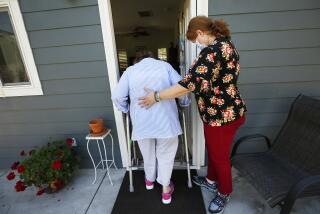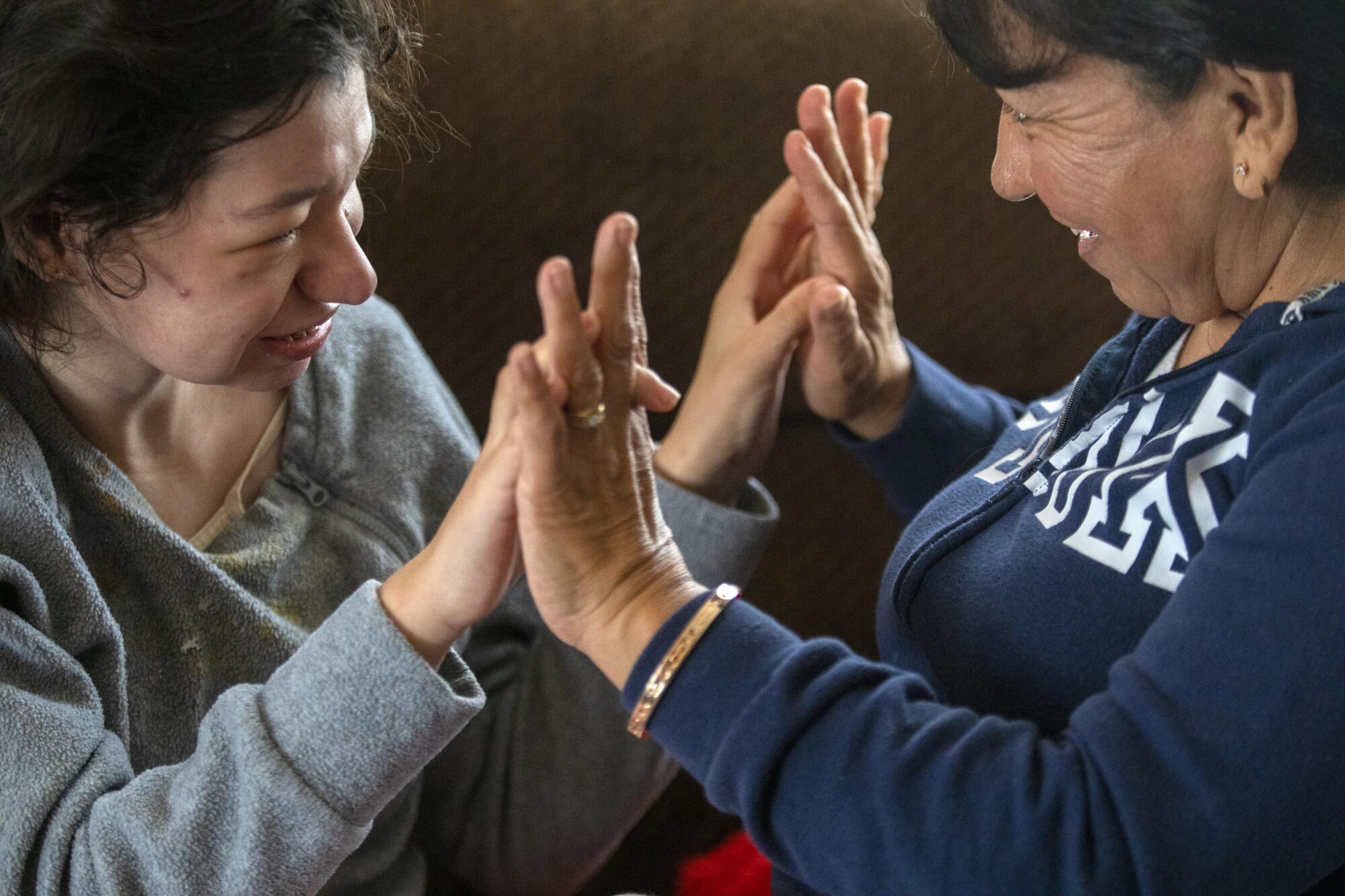
In the mornings, Rosa Andresen showers hurriedly before her daughter wakes up, worried the 24-year-old might suffer a seizure or tumble out of the bed while she is still shampooing her hair.
Her daughter Amanda Andresen, who does not speak, was born with a condition affecting the part of the brain that bridges its left and right sides. Her walking is unsteady, and she needs to be assisted from the moment she gets up.
In the front room of their South Gate home, Rosa guided Amanda gently from a cushy sofa to the dining table, where she had prepared a mixture of Malt-O-Meal and crumbled bits of toast smeared with peanut butter, stirring them until they grew mushy enough to swallow.
“I’ve been doing everything since birth for my daughter,” Rosa said, feeding Amanda the Malt-O-Meal one spoonful at a time until her daughter pushed the bowl away.
When her husband died nearly a decade ago, Rosa worried about how she would pay their bills, since she couldn’t leave Amanda daily to work. That was when someone told her about the In-Home Supportive Services program. It pays assistants to help people who are elderly or disabled stay safely in their own homes. Rosa became a paid caregiver to her daughter through the program.
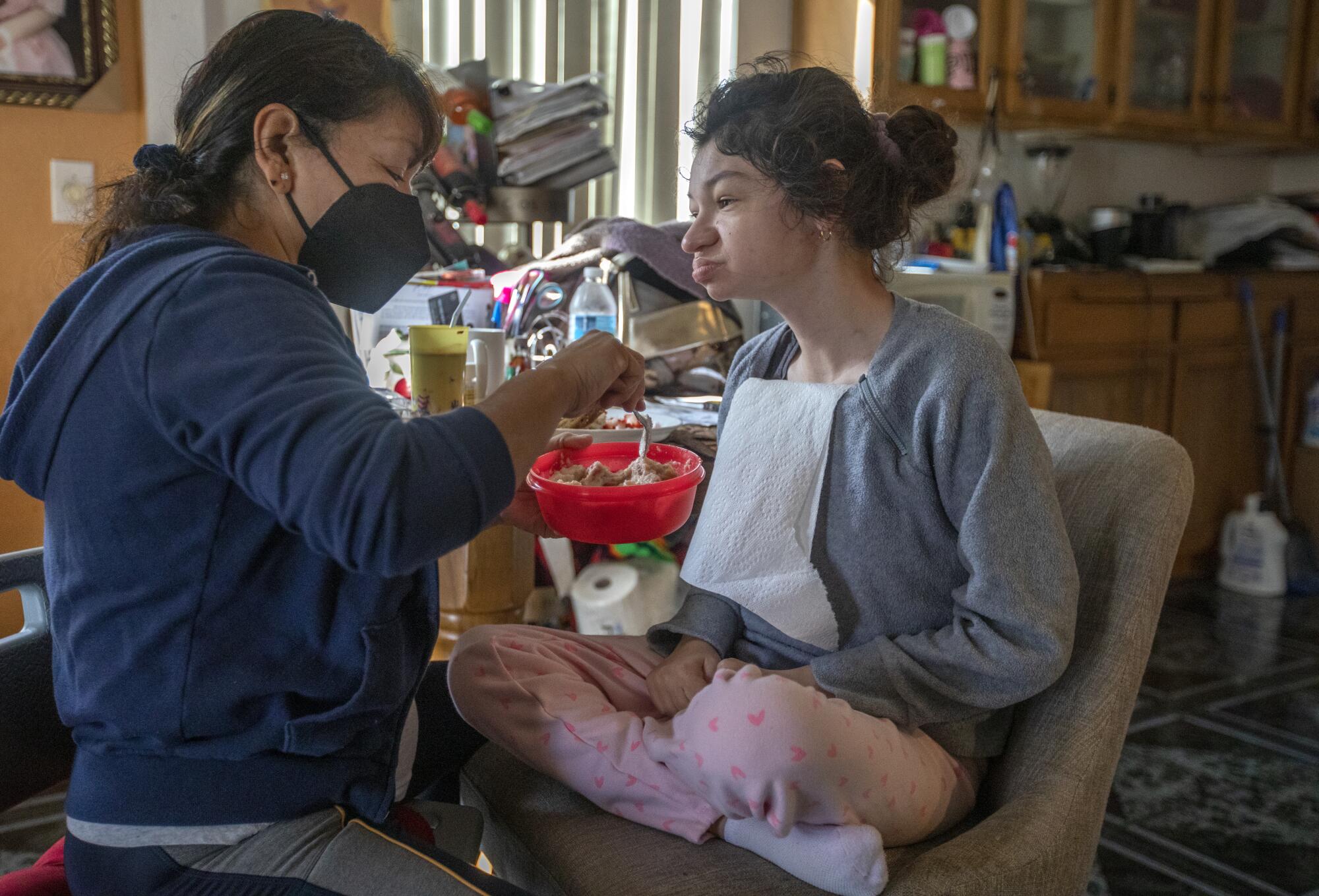

But Rosa earns only $16 an hour, straining her budget as prices tick upward for groceries and gas. Her landlord has notified her that she needs to move out of her South Gate unit so that the landlord can move in, she said. Finding another home that she can afford and putting down a deposit feels “almost impossible” on her current wages, she said.
For more than a year, workers like her have been pushing for higher wages in Los Angeles County. Each county has its own hourly rates for workers in the program, which range from $15 to $18.75 across the state. In Los Angeles County, the $16-an-hour rate is just four cents above the minimum wage for unincorporated areas.
Across the state, experts and advocates argue that paltry wages and a painfully complicated funding system have hampered a program that can prevent people from having to leave their homes and move into more costly facilities.
Without the IHSS program, Rosa said, Amanda would probably have to move into a nursing home or some other facility at government expense. Instead, Amanda has been able to stay in her longtime home filled with her Blue’s Clues toys and family photos, attended by a parent who can read her unspoken signals, knows her love for long baths and heavy metal music, and is attuned to the signs of her seizures.
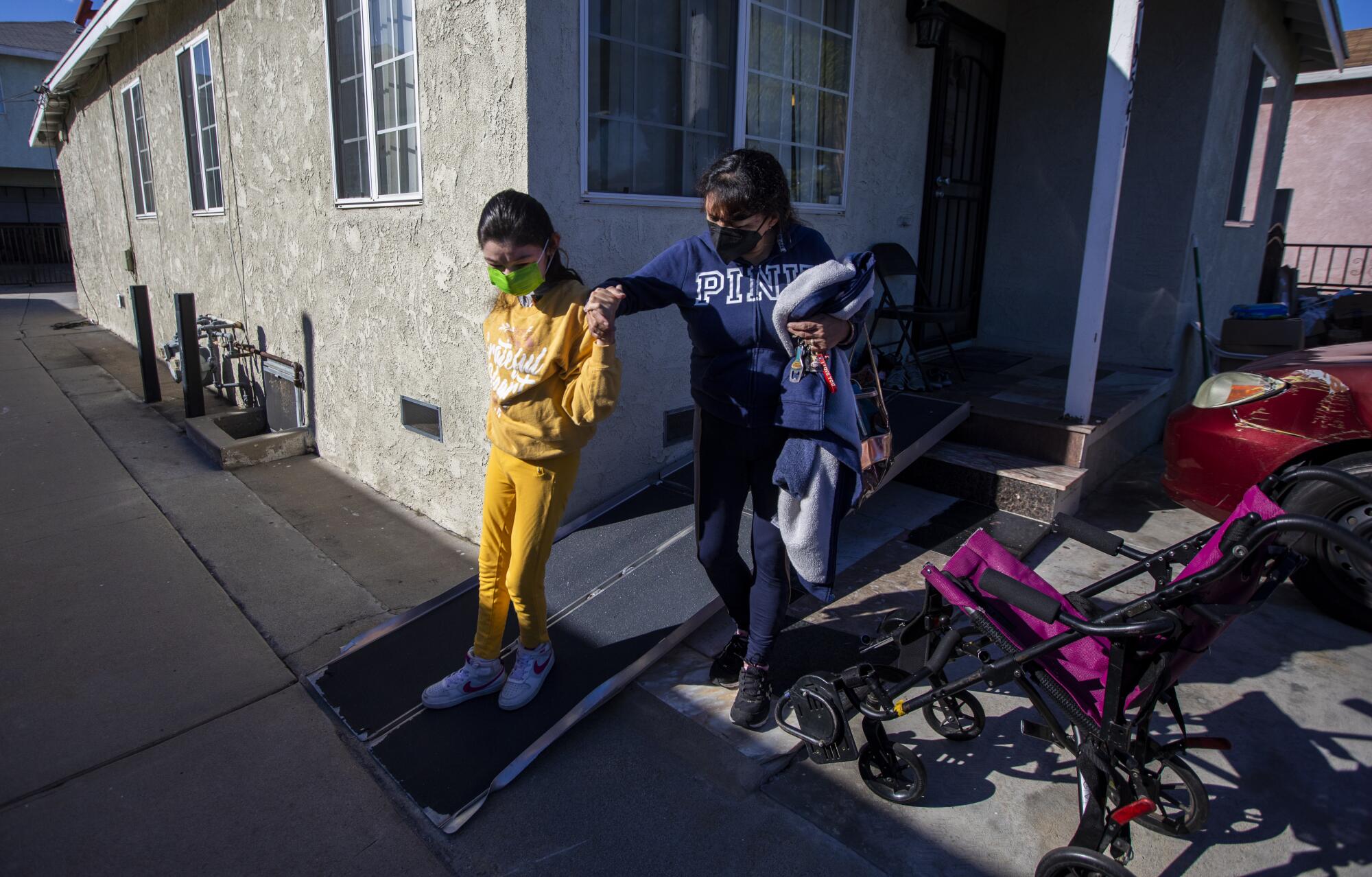
In October, a crowd of caregivers in purple shirts brought a meeting of the L.A. County Board of Supervisors to a halt, chanting, “Time for 20!” after workers testified. SEIU Local 2015, the union that represents the caregivers, has been calling to bring them up to $20 hourly within a few years and bemoaning the slow pace of negotiations since their last agreement expired over a year ago.
“If we go on earning what we’re earning, we’ll end up on the streets,” Blanca Carías said in Spanish. Carías cares for her elderly mother through the program, allowing the 90-year-old cancer patient to stay in her home. She said she has had to choose, at times, between paying for groceries or rent in Los Angeles.
As society mires its way out of the COVID-19 pandemic, health coverage has come into sharp focus for all.
“I’d like for [the county supervisors] to spend one week in our shoes to understand,” she said.
Across the state, the program has grown dramatically over the past decade, and demand is only expected to keep rising with an aging population. More than 245,000 people in L.A. County are authorized to get assistance through the IHSS program, aided by more than 200,000 providers, according to data from the Department of Social Services.
Arnulfo De La Cruz, president-elect of SEIU Local 2015, called them “the largest public workforce in Los Angeles County” and said the majority are women of color. More than two-thirds are caring for a family member, state data show.
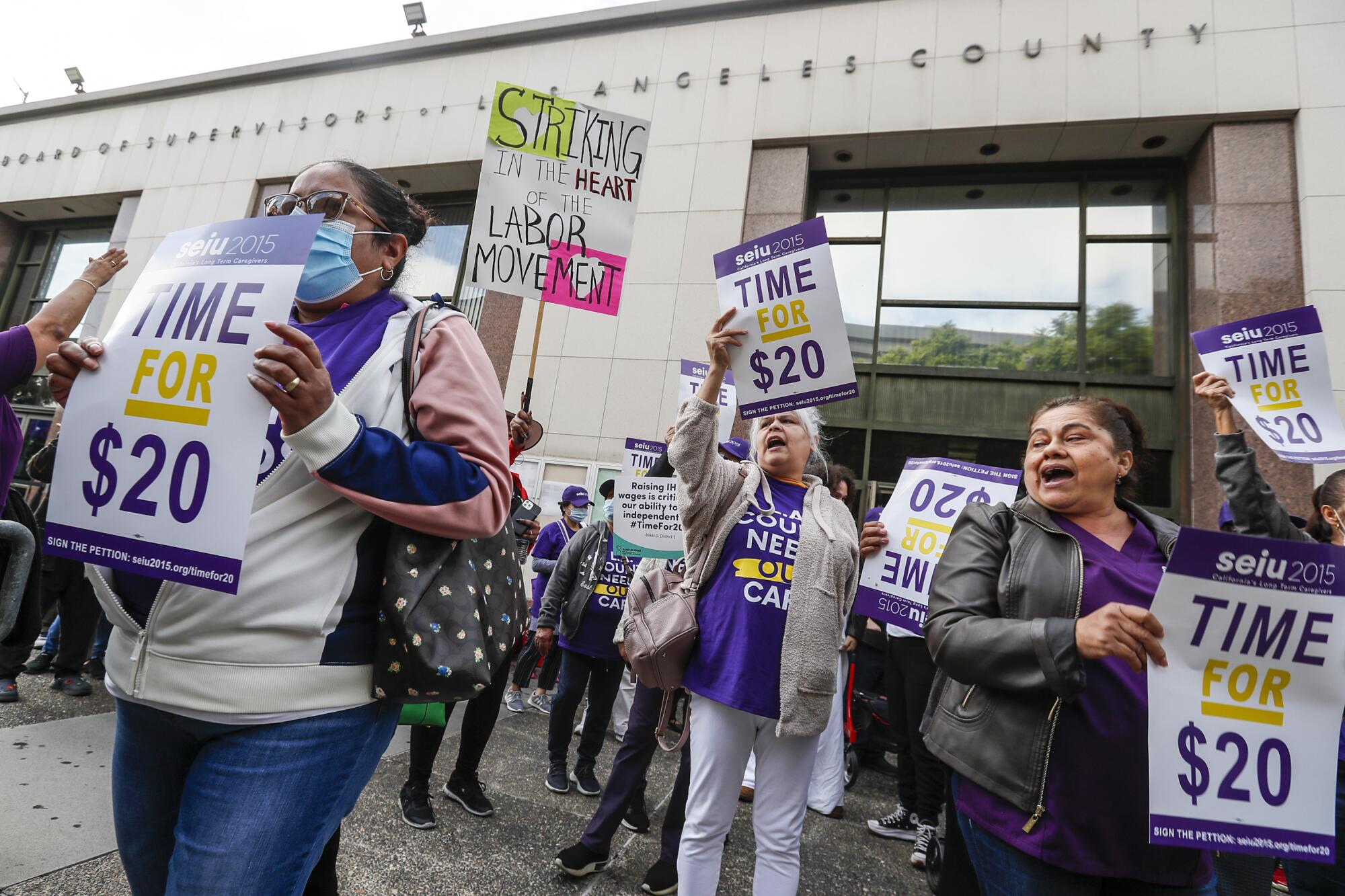
Among those pushing for higher pay for the IHSS workers are people with disabilities who rely on their labor.
“A huge issue, within our community, is the sheer shortage of people who are willing to do it because of the wages,” said Lara Minges, 47, a Sierra Madre resident who relies on an attendant to assist her with daily needs including getting out of bed, going to appointments, preparing meals and staying hydrated. The program is “really a matter of survival. ... Without my attendant I could die, and I would die.”
Minges said she had struggled to find someone to assist her after her mother died.
“As soon as they hear that I need that much physical assistance, nobody is willing to do it for $16 an hour,” said Minges, who uses a wheelchair. Her nephew ended up coming out from New Hampshire to help her and it took months to get him approved under the program, she said.
As disabled people, “we worry that if we lose it, or if the wages don’t go up, we’ll be without care and we’ll be institutionalized,” losing independence, said Minges, who is a social worker.
Last year, the California State Auditor released an audit that faulted low wages for making it hard to recruit needed caregivers, lamenting that tens of thousands of Californians were not getting the care that they needed each month. (In L.A. County, SEIU Local 2015 has estimated that 750,000 authorized hours go unused every month, which it attributed to a shortage of providers.)
In many counties across the state, wages were so low that IHSS caregivers without any other income would qualify for public assistance, the audit found.
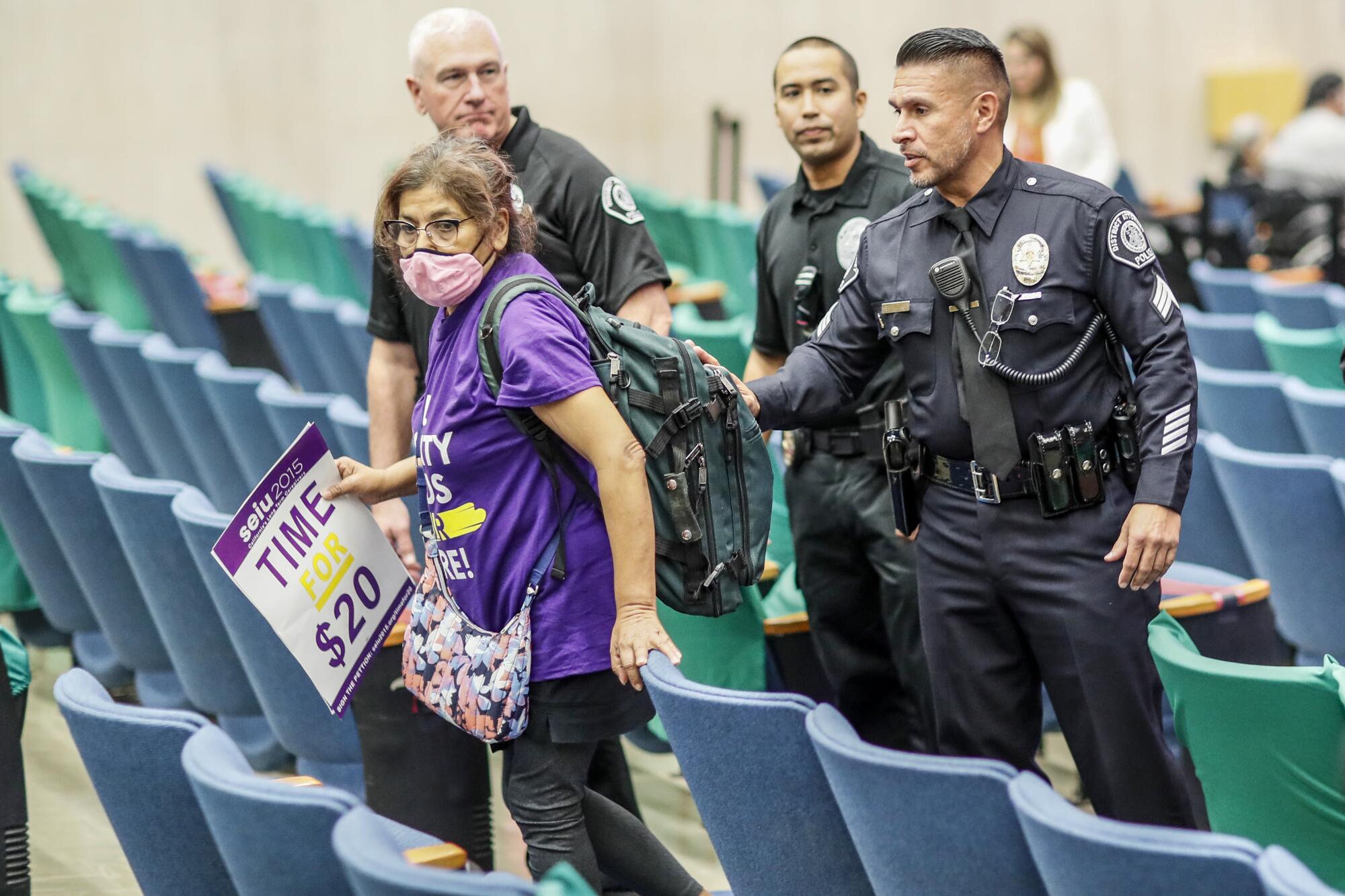
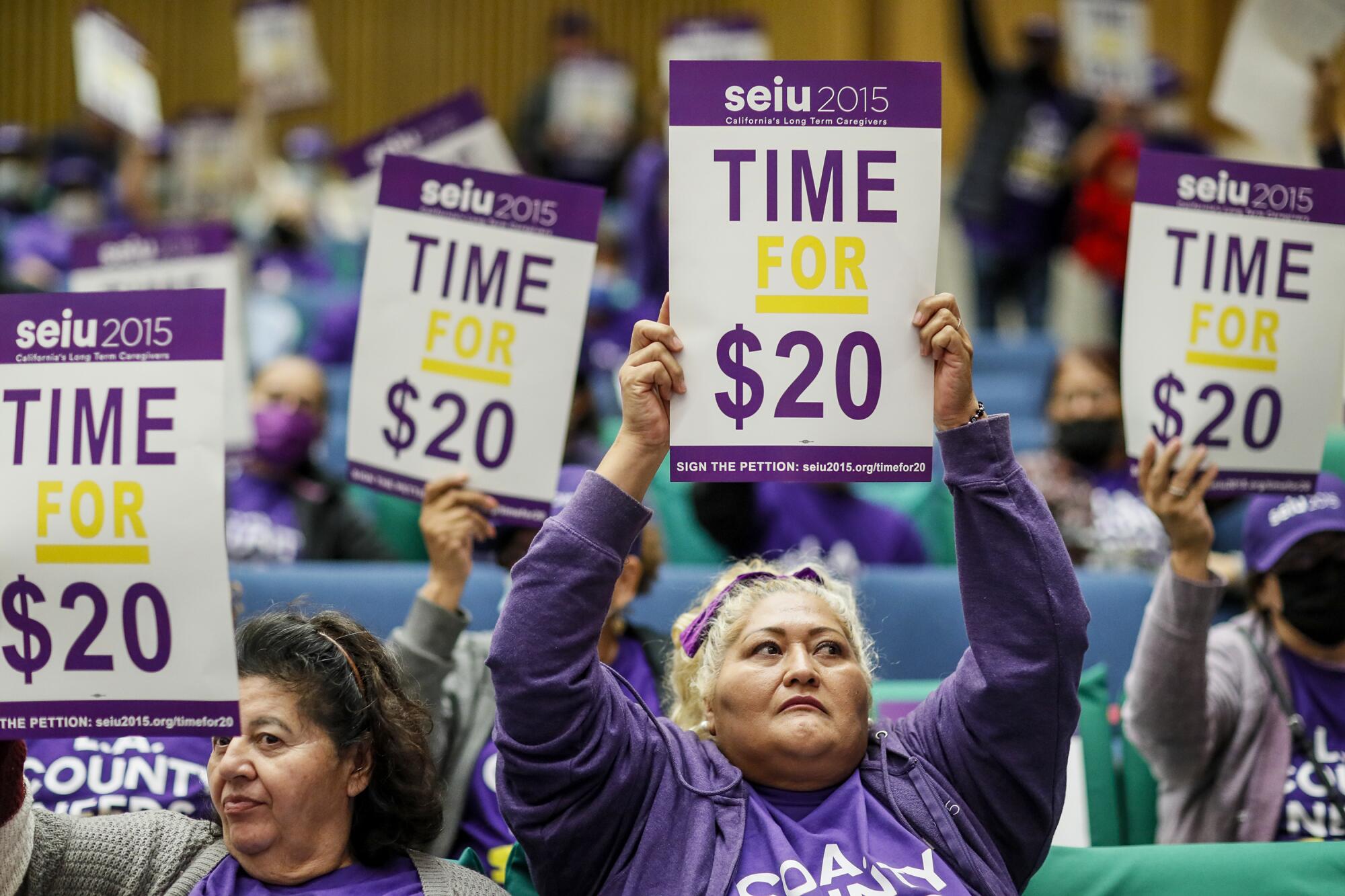
In L.A. County, their contract is with the Personal Assistance Services Council, a public authority established by county leaders decades ago, which has a contract with L.A. County to assist with the program.
In a written statement, the Los Angeles County Chief Executive Office said it valued their important services and was working with PASC and SEIU 2015 to evaluate the wage proposal.
“While negotiations remain underway between PASC and SEIU 2015, the county is limited in its ability to comment, but we would like to underscore that funding the county’s share of a wage increase of this size would require significant cuts to other critical county programs and services,” the county chief executive office said in its statement.
In the last budget year, the county said it spent nearly $640 million of its funds on the program, with the federal and state government covering the bulk of its $5.6 billion cost. Increasing hourly wages to $20 has been projected to cost the county more than $364 million annually if it took effect in or after January 2023, based on the way costs are split with the state, the executive office said.
SEIU Local 2015 calculated a much lower estimate, saying that it wants the increases to be phased in, and argued it would amount to a tiny fraction of the $44.6-billion county budget.

The union also pointed to an analysis undertaken for SEIU by the consulting firm Beacon Economics, which found that such a wage increase would generate nearly $300 million annually in added revenue for government agencies through various taxes, as well as a ripple effect of more than $2 billion annually in added economic output from caregivers’ increased spending.
In general, “the cost of keeping someone at home, with a program like IHSS, is far less than if they were to end up in institutional care,” said Kathryn G. Kietzman, director of the Health Equity Program at the UCLA Center for Health Policy Research.
One analysis, performed more than a decade ago when California was considering cuts to the program, concluded that if IHSS were eliminated and even a fourth of IHSS recipients had to go into nursing homes instead, the state would end up spending more to care for fewer people.
Among those arguing for higher pay for IHSS workers at the L.A. County Board of Supervisors meeting in October was California State Assemblymember Reggie Jones-Sawyer, who said his mother would not have survived without home care. “For me, there is no question that they deserve all the money that they need,” Jones-Sawyer told the board.
California’s program to provide in-home care for its low-income elderly and disabled residents finds itself once again at the heart of a state budget standoff.
County Supervisor Holly Mitchell, the board chair, replied to Jones-Sawyer that she looked forward to partnering with state representatives in “making sure that state resources are at the table as well.” In a later interview, Mitchell mentioned concerns about how funding is split between the county and the state, saying that “perhaps we should look at that.”
State auditors concluded, in their report released last year, that the way the caregiving program is funded — which involves a mixture of federal, state and county funds — discourages counties from hiking wages by increasing their share of program costs, especially if a county agrees to boost pay by over 10% in three years.
The California Department of Social Services, which helps administer the program along with counties, disputed the idea that the funding system dissuades counties from upping wages. It said that counties had incentives to negotiate wage increases, including the option to agree to a “wage supplement” over the state minimum.
Consultant Carol Wilkins, who has been analyzing the IHSS program for the L.A. County Homelessness Initiative, said she wasn’t surprised by the complicated back-and-forth between the agency and state auditors. “This is the strangest, most complicated funding arrangement,” Wilkins said.
The bottom line is that wages have remained low for IHSS workers across most of the state, she said. In the Bay Area, where Wilkins has joined meetings with program directors, “they have huge workforce shortages because people can’t afford to do this kind of work.” A February survey of SEIU Local 2015 members who are IHSS workers found nearly a third had at least one other job.
One alternative model, now being used in San Francisco, is having some IHSS workers hired through an agency that contracts with the county, rather than being directly hired and supervised by people in need of assistance. That model has been eyed as a better fit for people with medical or psychiatric conditions that make it difficult for them to manage their own providers.
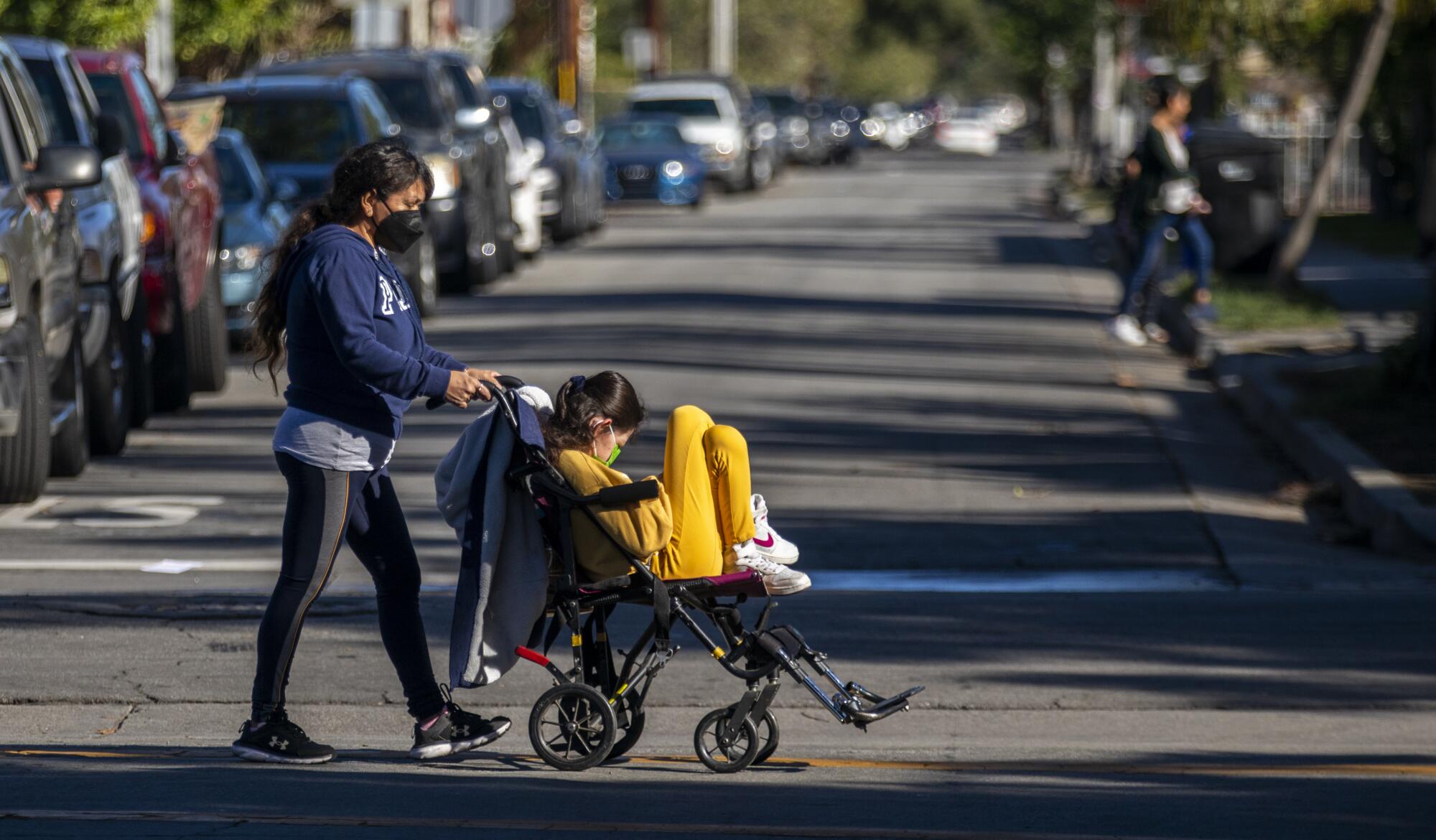
The San Francisco contractor, a nonprofit named Homebridge, advertises that its home care providers start at an hourly rate of $20.25. But Wilkins said that has been “virtually impossible” for other counties to replicate so far due to cost.
San Francisco has had the political will to help fund the program, but the structural problem, more broadly, with IHSS wage increases is that “the people who pay the healthcare bills and the people who pay the IHSS bills” don’t draw from the same government funds, said Mark Burns, executive director of Homebridge. If people are unable to remain in the IHSS program and end up in nursing homes or hospitals, their bills end up being covered by “the healthcare side of the system.”
In South Gate, Rosa Andresen has been pitching into the union effort by making phone calls, for which SEIU 2015 pays her a small stipend. L.A. County leaders “tell us they appreciate everything we’ve done,” she said. “Yet we’re being forced to come, week by week, to express our needs” at the board meetings. “I almost feel like they’re ignoring us.”
After Amanda pushed away her breakfast bowl, Rosa helped her up to the bathroom. “Come here, let’s go brush your teeth,” she said as they maneuvered down the hall. In the bathroom, she tucked a towel into the neckline of Amanda’s shirt, steadied her head, then gently cleaned her teeth with the brush. She cupped her hands to scoop up water for Amanda to rinse her mouth.
“One more,” she coaxed her. “All done.”
For Amanda, the program has kept her home with the family she loves. Her Sundays are spent with relatives at the grave of her grandmother, where they spread out a blanket, play music and pray the rosary. When Rosa mentions her younger brother will visit soon from UC Berkeley, Amanda goes incandescent with joy.
It was the job that made it possible, for years, for Amanda to have this home. Rosa hopes the paycheck won’t make it impossible for them to find another.
More to Read
Sign up for Essential California
The most important California stories and recommendations in your inbox every morning.
You may occasionally receive promotional content from the Los Angeles Times.




